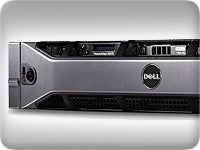
Hyper-converged is the latest buzzword coined to describe the merging of cluster-based compute, networking and storage into a single box. At least that’s one specific implementation which fits the definition.
Traditional designs of enterprise-class virtualization solutions typically utilized  some type of storage area network (SAN) attached to a number of commodity servers and interconnected with high-end networking.
some type of storage area network (SAN) attached to a number of commodity servers and interconnected with high-end networking.
Dell is one of a number of vendors offering what is essentially a cluster in a box. The FX2 and PowerEdge FC630 combination packs four physical nodes into a single 2U rack mount space.
It makes a perfect platform to implement a small VMware VSAN cluster capable of supporting a number of different workloads. The FX2s version provides two PCIe switches and eight low-profile PCIE expansion slots, which allows for two cards per half-height sled.
The FX2 platform provides a number of configuration options to meet specific usage scenarios. Nodes come in quarter, half and full-width sizes. We were provided with two half-width PowerEdge FC630 modules for our review in an FX2s chassis.
It is possible to mix and match different sized modules depending on the use case. In addition to the compute nodes Dell offers the half-width FD332 storage module, which has room for up to sixteen small form factor drives.
Each PowerEdge FC630 in our review unit had two Intel Xeon E5-2650 v3 processors and 64GB of memory. The FC630 supports up to 768GB of DDR4 memory and the full range of Intel E5-2600 v3 processors.
Storage options include two 2.5-inch drives or up to eight 1.8-inch SSDs. You can also configure the system with PowerEdge Express Flash NVMe PCIe SSDs for high-end disk speed requirements.
One of the key features of the hyper-converged concept is the use of internal networking to eliminate the need for an external switch and the requisite cabling. The LAN on Motherboard (LOM) network provides four connections per half-width compute sled.
Dell’s FN IO Aggregator provides high-speed 10GB paths between all nodes and multiple external 10GB connections. With room for two FN IO Aggregators you have the ability to implement dual redundant 10GB paths between all four nodes.
Dell’s iDRAC management software shows up both at the chassis level in the Chassis Management Controller (CMC) and on each individual node. The CMC module plugs into the rear of the FX2 and provides two Ethernet connections plus a DB-9 serial connector. The second Ethernet port makes it possible to daisy chain multiple FX2 chassis together without the need for an external switch.
Figure 1 shows the Server Status page from the CMC for node 2. It provides convenient buttons to launch the iDRAC GUI for the module and the remote console app. Dell uses a Java-based terminal emulation app so you’ll need to have Java installed on the system you wish to use for this purpose.
Figure 2 shows the Power Monitoring screen with both a running graph showing Average Watts and an instantaneous power meter with the warning and failure levels clearly labeled.
The front of the FX2 chassis has a VGA monitor connector should you need to manage the system up close and personal. A KVM button on the front panel cycles between the different nodes to allow direct connection to each system. You can not connect to the CMC through the front panel as it requires an IP connection.
Our review unit came with Windows Server 2012 R2 installed on both PowerEdge FC630 nodes. We were able to enable the Hyper-V role on both nodes and successfully migrate virtual machines between the two nodes. We used Windows Server Manager to add the Hyper-V role and to do things like monitor the storage system and networking.
The Dell FX2 platform presents one of the most compact multi-node offerings in their entire product line. With a wide range of options it’s possible to configure a system for most any potential use case. Dell also recently announced the FC830, which is a new four socket full-width node for compute-intensive workloads. This product is based on the newest Intel Xeon E5-4600 v3 processor with from four to eighteen cores per CPU.
Using the management and networking daisy chaining capability makes it possible to build out a multiple chassis solution with no other external hardware required. The new storage node makes it possible to implement solutions not previously possible without some form of external storage.
The FX2 platform is truly a versatile building block capable of handling just about anything you want to throw at it. Prices for the FC630 start at $3189 for a system equipped with a single E5-2603 v3 and 4GB of memory.
Paul Ferrill, based in Chelsea, Alabama, has been writing about computers and software for almost 20 years. He has programmed in more languages than he cares to count, but now leans toward Visual Basic and C#.

Paul Ferrill has been writing in the computer trade press for over 25 years. He got his start writing networking reviews for PC Magazine on products like LANtastic and early versions of Novell Netware. He's been using and writing about Unix / Linux since before there was a Linux. Print publication credits include Datamation, Federal Computer Week, Information Week, InfoWorld, Network Computing, Network World, PC Magazine, and PC Computing. He's written for multiple web sites including IBM's Developerworks site. He recently had his first book published by Apress entitled "Pro Android Python with SL4A". Paul holds both BSEE and MSEE degrees and has written software for more computer platforms and architectures than he can remember.
Property of TechnologyAdvice. © 2025 TechnologyAdvice. All Rights Reserved
Advertiser Disclosure: Some of the products that appear on this site are from companies from which TechnologyAdvice receives compensation. This compensation may impact how and where products appear on this site including, for example, the order in which they appear. TechnologyAdvice does not include all companies or all types of products available in the marketplace.